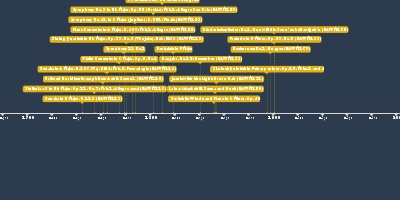jan 1, 1853 - La traviata: Act III, Scena and Duet (NAWM 150)
Description:
Composer: Giuseppe VerdiGenre: Opera
Translation: The Fallen Woman
This opera was a rarity for Verdi because it was set in Verdi’s modern time.
Plot
Violetta (the traviata of the title) gave up her career as a courtesan to marry Alfredo, who has fallen in love with her. Alfredo’s father, believing Violetta’s reputation will ruin his daughter’s chance to marry a respectable suitor, successfully persuades Violetta to leave Alfredo, which she does without telling Alfredo her true motives. After a duel with one of Violetta's old admirers, Alfredo leaves France. In act three, Alfredo’s father repents and tells his son of Violetta’s sacrifice. Alfredo returns to ask her forgiveness but finds her gravely ill with tuberculosis. She agrees to leave with him but her illness is too great; she dies in his arms.
Form of this scene
Overall, this entire scene is a recitative accompanied by the orchestra.
1. A tempo d'attacco (E major): opening action in which Alfredo and Violeta reunite and trade phrases of melody in dialogue.
2. Slow lyrical catabile (Ab major): The lovers swear they’ll leave Paris together.
3. Tempo di mezzo, in which somehow the situation or characters’ moods are altered. In this scene, their hope of leaving Paris together turns to despair due to Violetta's illness. The momentum collapses when she realizes that she will not improve.
4. Fast Cabaletta (C major), meant for more active emotion like joy or anger. In this scene, it is not the usual rousing close but rather expresses her desperation and builds to a climax of despair.
Orchestration
Verdi's orchestration intensifies the emotions and deepens the drama, using strings as the main accompaniment and the winds and brass as the color. He included a piccolo, providing extra sparkle, and a contrabass trombone, which adds depth and force. His use of these special instruments in the most pivotal moments of the scene heightens the contrast and thus overall dramatic effect.
Changing Values
That every note is written out is a sign of how much the composer is now in control, a complete turnaround from the expectation of improvised embellishment by singers of Rossini’s operas four decades earlier.
Added to timeline:
Date:
jan 1, 1853
Now
~ 172 years ago
